


On the 16th of August 2004, Serenity Systems officially released eComStation 1.2. The first questions I noticed in the newsgroups appeared about 12 days later, but not anything dramatic, and certainly no reason for me to delay purchasing the 1.2 update. As before eCs is available in three languages, Dutch, English and German, plus the various upgrades from Warp4 , eCS 1.0 and 1.1. Whats new however is a “Academic” Version with a price discount of between 13 and 20 percent. Another change in marketing, is the availability of the application pack to all customers. This was previously limited to eCs customers only. The contents of the application pack have also changed.
|
Application Pack eCs 1.1 |
Application Pack eCs 1.2 |
|---|---|
|
Lotus SmartSuite for OS/2 version 1.7 |
Lotus SmartSuite for OS/2 version 1.7.2 |
|
HobLink X11 server |
OpenOffice.org |
|
Sti Applause + Scanner drivers |
Serenity Virtual Station (Beta) |
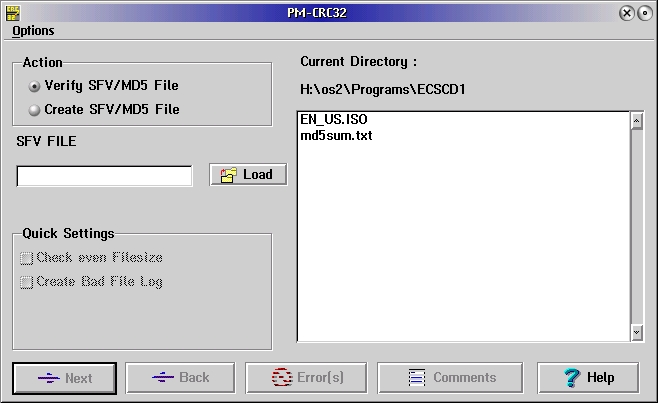
The next part is to burn the CD's. If at this stage you only have Windows and Nero you can refer to Creating eComStation install CD's under Windows. On CD1 a MD5 checksum text file (MD5SUM.TXT) is present but there is no utility on this disk or on CD2 which can be used to check file integrity. On eCs 1.1 there is a check program but this has a different format for the checksum file. Only by changing the order of information on each line and adding dummy information to satisfy the parser can this program be used. The checksums were I understand, generated using one of the Mozilla tools (Moztools.wpi) md5sum but under Linux, which gives checksum errors under OS/2. This is due to differences in the default method of opening files (binary as against ascii). At this moment there is no solution but it is being investigated by Mensys.
The installation process is at first identical to eCs 1.1 with some minor cosmetic changes. There is still the “Easy”, “Advanced”, and using a “Response file” which as with 1.1 is still grayed out. However in comparison to eCs 1.1 there is a message which indicates that in in the documentation (which I don't have, so I can't test it) there is a description on how you can activate this. As before it is also possible to select the management console.
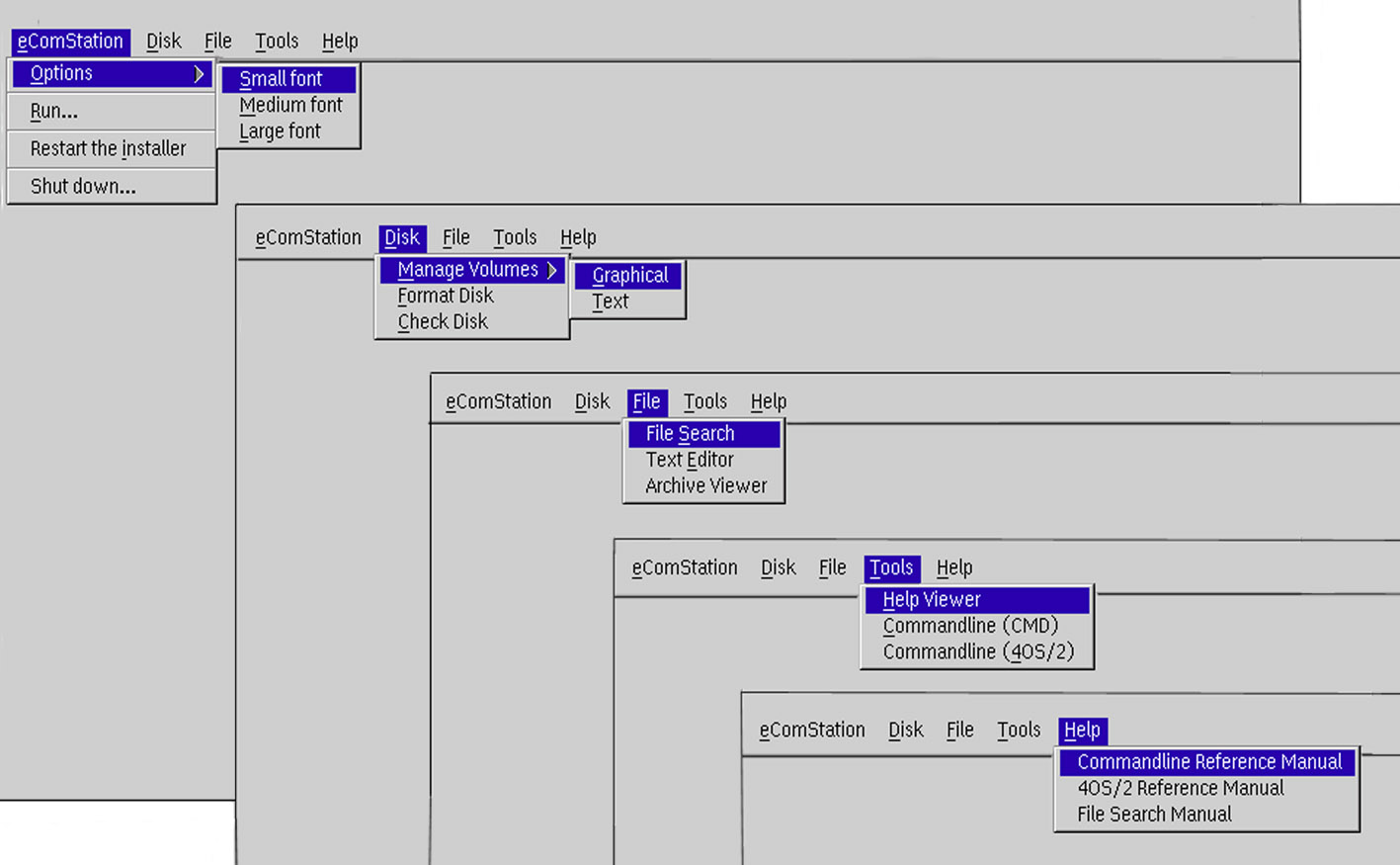
If you want to continue with the installation however you will now be presented with the registration screen which was in 1.1 a few pages later. The registration data has become shorter. Four lines of 22 characters instead of 32 last time. I prefer to use the import facility as I have stored the registration data from my email on a floppy. By the choice on whether or not to format your disk you are told that not formatting will result in a migration of your current installation . I suppose the main difference that you will notice is the multimedia setup page, whereas multimedia support was executed as a last part of the installation and the sound drivers you added manually from CD2, its now done before you set up your network. A big improvement. The rest of the install is identical to 1.1 although if you start digging in the options tree page you will notice a number of minor changes, for example that it is no longer possible to select/deselect the APM drivers. They are always installed! Also under the option Bonus Applications on the “Select Components“ page additional items are listed. On the same page a new options is given to allow you to point to your default “home” and “programs” directory. This is probably one of the few times you might use the browse button to the right of the Destination window marked “....” You will be disappointed as it is only possible to walk through the drives but not through a directory tree, making the browse button useless! The rest of the settings pages are almost identical to 1.1. Serenity should be complement with the changes made to the text on the various settings pages as these are now much clearer and conciser.
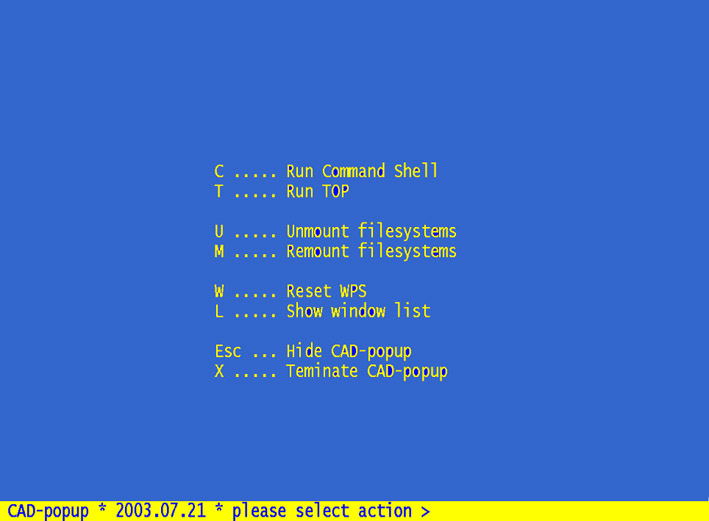
From this program it is also possible to start the TOP program (see Fig 4) which gives a
list of process and the amount of CPU time they are using sorted on
cpu load with the highest first. It is not
a true load monitor as the statistics calculated are from a previous
period which is 2 seconds by default. Now instead of just killing a
program you can kill process.
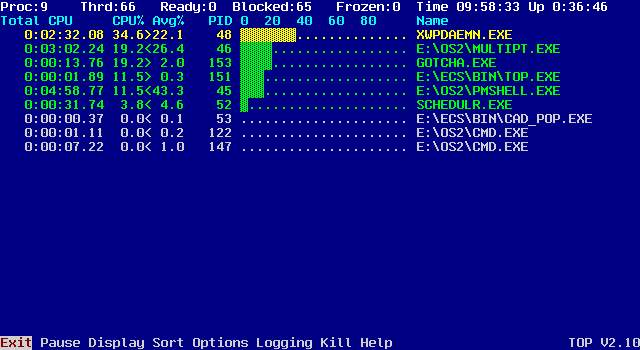
Fig 4 - TOP
A small oversight if you try to use the HELP function the system will report that it cannot find the help file. Its there, together with other documentation in the directory \ecs\doc\top. Just make a copy (a shadow doesn't work) of the file “top.txt” to “\ecs\bin” and all is cured. I found a similar problem with the help file for SLPR not being directly accessible as well. The help file is in the system but not where the program expects it to be. You might find other programs which react in the same way!
Another thing I noticed was that CONFIG.SYS is sorted by cfgSort v 5.0. Nice. This utility is stored on your hard disk but theres no icon on the desktop or in one of the desktop folders. The Warpin installer ver.1.0.2 build 437, is also installed. Another thing you might notice if you are using DHCP that during boot, a timer is started which counts down in 5 second increments while the system is waiting to get its dynamic IP address. Innotec's font manager and runtime routines are also installed together Mozilla (ver. 1.7) with the Acrobat and Flash plug-ins already installed.
A welcome addition is
the EscapeGL screensaver from Snow Storm Software. Its a jazzy
screensaver (see Fig 5) with a wide range of 3D effects.
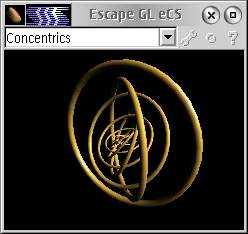
Fig 5 - EscapeGL, the screensaver
Of course there are
more things, some of which are very noticeable such as RSJ's CD
writer. It is a speed limited version but with an annoying pop-up
which comes up every time you use it. Then there's eCSCoNet
which should help all of you with analogue, ADSL or ISDN connections.
If you want to have access to your desktop from another computer then
there is PMVNC. After simply entering a password the first time PMVNC
is started I can use my web browser on my Windows machine and both
see and access my desktop with ease. You can see the result in Fig 6.
Most noticeable is the color differences of the background probably
caused by the limitation in the color resolution in the transmission.
Also only parts of the screen are sometimes updated as can be seen by
the residual created by a right click on the trash can (upper right
hand corner) and the consequential selection of the foreground
window.
Nevertheless
excluding these details, I could do anything at a distance (that I
tried) from my web browser that
I could otherwise only do when in front of my PC,
with just a fraction of a seconds delay. Amazing!
As with eCs 1.1
running install.cmd, found in the root of CD2, will
start up a PM program allowing you to select via tabs the additional
software you would like to install. Many of the programs on the
second CD are identical to those found on eCs 1.1 some have
disappeared and others have taken their place. To give you an idea of
the differences I have listed the contents of both CD's below. The
things which I consider most significant which are missing, is the
reset of MMOS which was included in the tab multimedia with CD2, and
the maintenance tool. For the rest most of the programs are now
integrated in the base install which is a definite improvement.
ECS 1.2 ECS 1.1 Flash 5 (included
in Base install CD1) Flash 4 & 5 Netscape plugin
Pack Mozilla 1.7
(included in Base install CD1) Mozilla 1.3 Desktop on Call 3 Desktop on Call 3 Desktop on Call 4 Desktop on Call 4 eCS Maintenance Tool Java 1.3.1 (note Java 1.4.2 is in the base install) Java 1.3.1 Streaming Line
Printer(included in Base install CD1) Lucent Modem
Support for Thinkpads Lucent Modem
Support for Thinkpads Mars Game Multimedia
(included in Base install CD1 ) Multimedia - Open GL 1.1 Elsa Card Support. Elsa Card Support. Haupage Card
Support. Haupage Card
Support. Legacy IBM
Support. Legacy IBM
Support. LBMISX &
Cinema/2 LBMISX &
Cinema/2 Acrobat 4
(included in Base install CD1) Acrobat 3 Ecosoft Cool FM &
PM Downloader Ecosoft Cool FM &
PM Downloader Maul Publisher Maul Publisher Norman 5.4.7 Norman 5.4.3 RSJ CD Writer 5.06
(included in Base install CD1) RSJ CD Writer 5.01 PostgresSQL PostgresSQL Warpin Installer
(included in Base install CD1) Warpin Installer ISDN Drivers
(Eicon, Elsa, HST, Teles) ISDN Drivers
(Eicon, Elsa, HST, Teles) ECSCoNet (included
in Base install CD1) ECSCoNet
- Network ini File
synchronizer - TCPIP Stack Tuner Mobile File
System. Mobile File
System. Novell Network
Client Novell Network
Client Open Watcom Open Watcom IBM Toolkit IBM Toolkit Device Driver Tips Device Driver Tips IBM Bonus Pack
(Warp4) IBM Bonus Pack
(Warp4) (included in Base
install ) Flash 5
- Migration Tool Hoblink X11 Hoblink X11 - Scitech Display
Doctor 7.1.1 FAT 32 Support. FAT 32 Support. Graham Utilities Graham Utilities IBM Web Browser
2.03 - Installation of
eCs 1.0 CD3
Installation of
eCs 1.0 CD3
eCS 1.2 is not a
revolution, but it is definitely an incremental improvement on 1.1.
The installation is more refined with better hardware detection and
support, although I still cannot install it directly on my AMD64
machine. The new utilities fill some of the holes not previously
plugged, but many of the enhancements are under the skin with the
latest fixpacks and drivers already
installed. If I was to evaluate eCs as an OS for the first time (I
know I am biased towards OS/2 but ... ) I would really like it. I
would however wonder why a really good file manager is still missing!
You may argue that not all hardware is supported. True, but a hell of
a lot is. What OS truly supports all
hardware. NT never supported USB! I suppose that the real test of an
OS is how it evolves over time, eCs has passed that test!!!
This article is courtesy of www.os2ezine.com. You can view
it online at http://www.os2ezine.com/20040916/page_2.html.
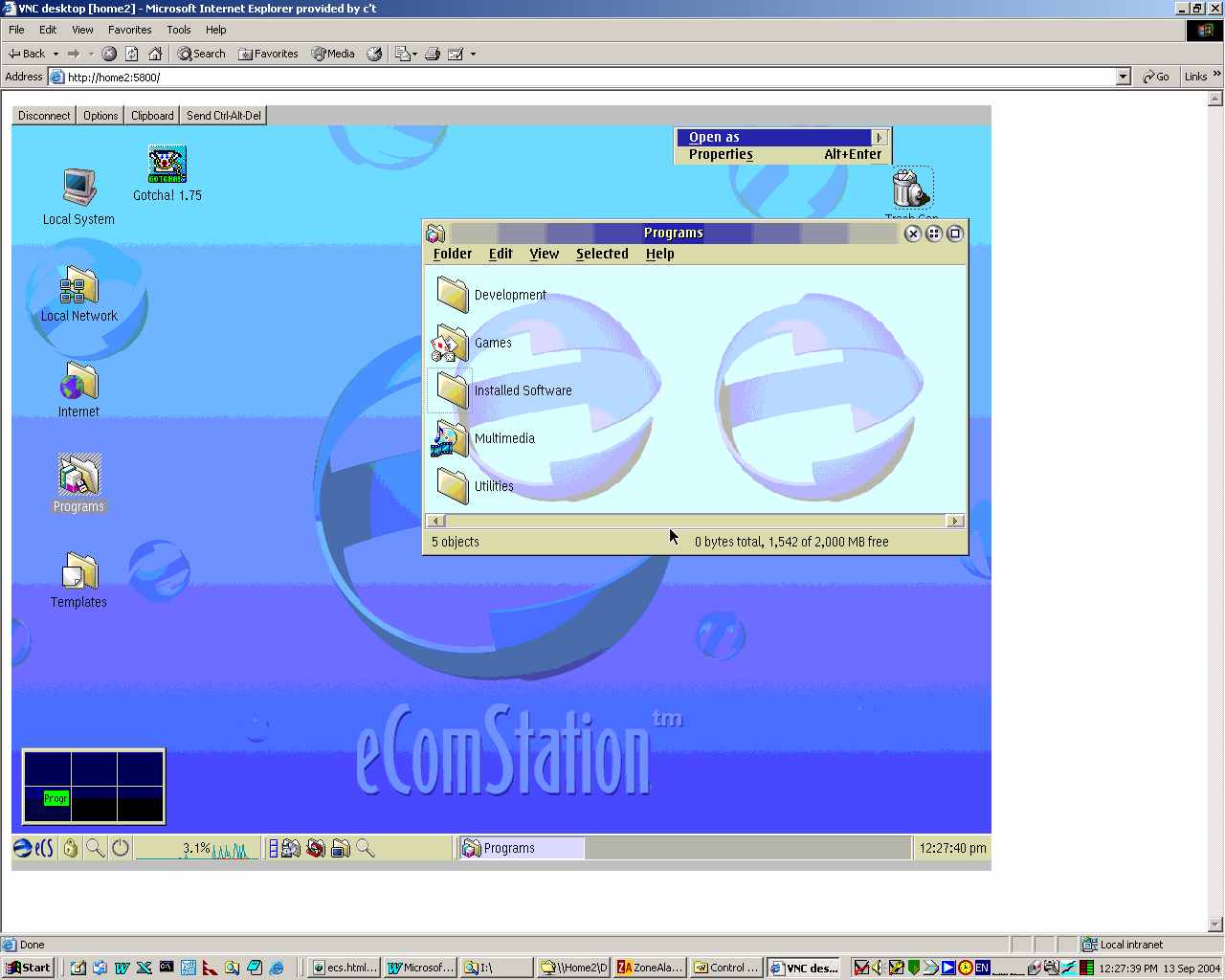
(click on image to get larger version)
Fig 6 - The eCs desktop using PMVNC as seen on a Windows 2000 machine
CD2
FAT32 support is
available but it is still hidden away in a directory (FAT32SUP) on
CD2, with a disclaimer text that it is unsupported software. This is
as far as I know the only piece of software on CD2 which has to be
installed by hand. Why this is not one of the optional installs with
a warning about being unsupported is to say the least a little
strange.
Streaming Line Printer
Stellar Frontier
Stellar
Frontier
Conclusion
Keith Merrington has been in computing since they used to be programmed
with punch cards and were made of discrete components and transistors. He built
his first computer soldering the chips in by hand ,back in the 80's before
the first PC was born. It was based on a Signetics 2650 8 bit microprocessor
with a massive1K memory and with two 8 inch floppy drives. He still builds
(assembles) his own PC's and has been using OS/2 since Warp 3 came out.
He is married and lives in the Netherlands but was born in London England.